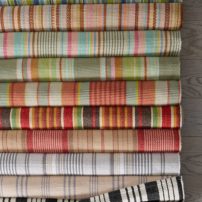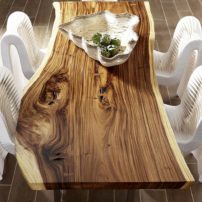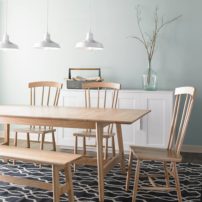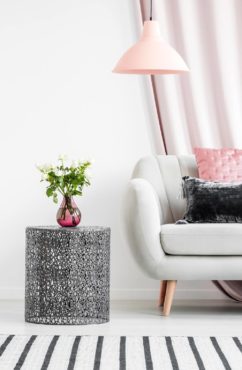 So many new trends coming our way for 2020. It’s been exciting to watch design ideas evolve. See what’s coming in new designs from colors and furniture to flooring and surfaces.
So many new trends coming our way for 2020. It’s been exciting to watch design ideas evolve. See what’s coming in new designs from colors and furniture to flooring and surfaces.
Every year, we gather our panel of design experts to discuss what are some of the hottest design trends.
In 2020, expect to see more high-performing fabrics, natural-looking finishes, natural materials like wood, and more recycled and upcycled choices for the environmentally conscious. Colors and patterns are becoming bolder. And, of course, the home is becoming more high-tech — there are new apps for just about everything!
As any good designer will tell you, trends come and go. The best advice for creating a timeless look is to choose based on quality, your personality and your lifestyle.
We’ve asked 15 designers to weigh in on what new and returning trends they are seeing, and to share some advice on how to use these trends for fresh design ideas.
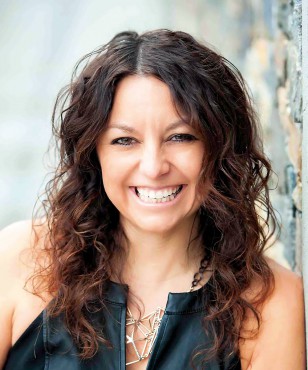 Alinda Morris
Alinda Morris
Alinda Morris Interior Design LLC
Gig Harbor • 253-579-8431
alindamorrisinteriordesign.com
nyvaqnzbeevf@tznvy.pbz
Alinda Morris is a nationally published, award-winning interior design professional, habitual remodeler, adventurous creative, entrepreneur, wife and mom, specializing in full service, luxury residential interior design: Custom furnishings, unique kitchens and artfully designed bathrooms, attention to details, and clean, updated spaces are her specialties. She has the experience, education and talent to provide interior styling that includes furniture procurement and installation. She also offers thoughtful space planning, detailed floor plans, elevations, sketches, finish selections, cabinet drawings and furnishings to take your remodeling project from beginning to magazine-ready completion.
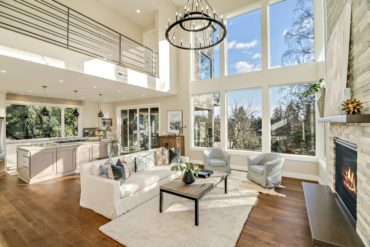
Alinda Morris notes a move away from the cooler gray interior colors in favor of brighter whites and warmer neutrals that are earthy and approachable, like Benjamin Moore pale oak and White Dove.
“These colors work well in both modern and traditional spaces because we are drawn to restorative colors found in nature,” she says. “In the spring, we will start seeing pastel colors ranging from pinks to blues and greens in both warm and cool hues. A powder room, laundry room or guest room is a great place to incorporate a fun, playful color.”
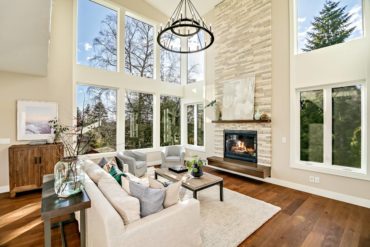
Bold: Colors such as deep purple, moss green and terracotta have been particularly popular.
Wall coverings: Wild exotics and defined patterns — anything inspired by botany — is very popular. Nature-inspired patterns and textures are also on trend.
Counter surfaces: Engineered stone continues to be the most popular. It is consistent in color and available in large sizes. Manufacturers claim it won’t stain and is nonporous. Therefore, it is low-maintenance and very easy to clean. It is only heat-resistant up to 300 degrees (some as 225 degrees) because of the resin that is used to hold the quartz particles together. Heat pads or trivets are recommended to protect the finish.
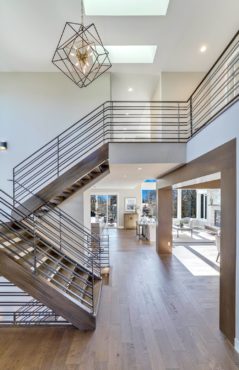
“If your budget allows, you can opt for a porcelain surfaces that is truly heat-resistant, like Dekton and Neolith. They are available in large sizes and different thicknesses,” Morris says.
Man-made products have a lot to offer but if you love the depth and variation of natural stone, she suggests sticking with granite.
“It is still very durable and beautiful. We love the leather finishes that are popular right now,” she says.
Fabrics: High-performance fabrics are very popular and can be soft and durable. Look for fabrics such as Crypton and Revolution — they can repel liquids, resists stains and reduce odors. Slipcovers in washable fabrics are still popular for easy maintenance.
Floor coverings: Morris recommends engineered flooring in wide plank. Brushed oak in beachy, washed finishes works well in our region over more exotic wood species. In tile, the trend is toward defined patterns and geometric designs and shapes. Three-dimensional tile in wood and ceramic is very popular in showrooms and widely available — consider your corners and the edge detail of these products.
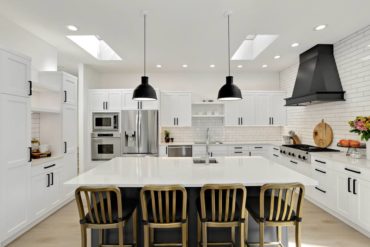
Furniture: Lighter wood finishes, cerused ebonized oak in light gray was consistent throughout High Point Market this fall. Organic materials and textures are inspired by the 1970s.
“We saw both rattan and cane furniture in bed frames, mirrors and lampshades in a wide variety of tactile finishes. We also saw lots of curved furniture, smoked glass. The ’70s revival trend is really fun and we look forward to seeing if design enthusiasts embrace it,” she says.
Lighting: Look for statement pieces in luxe finishes, mixed metals like aged brass. LED lighting has come a long way and continues to lead innovation in both interior fixtures and architectural lighting.
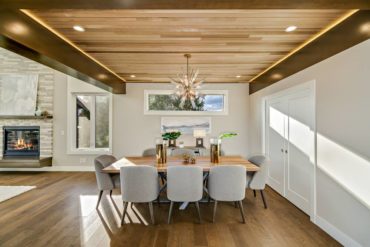
Finishes: Brass, bronze and champagne are popular.
Windows and doors: Black or graphite finishes are trending.
Window treatments: Trends include automation, natural textures and more modern profiles.
Morris’ advice to the homeowner for incorporating trends is to “start with the envelope of your space and build on the pieces you already own.”
“Have fun with trends,” she says. “Surround yourself with furnishings that you enjoy and try not to take it too seriously.”
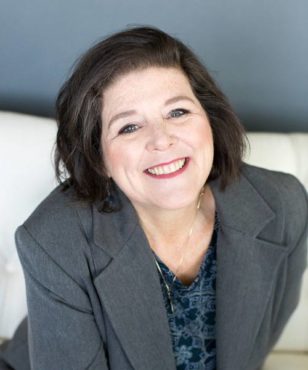 Janet Weber
Janet Weber
Janet Weber Interior Design
Poulsbo • 360-626-4484
janetweberid.com
Janet Weber owns and operates her own interior design business with the goal of creating atmospheres that are unique and well-suited to each client’s values, lifestyle and personality. She assists clients in realizing the vision for their homes and commercial spaces by guiding them through each phase of the design process, from the initial space planning to the final selection and placement of accessories. Weber received her bachelor of arts degree from Washington State University and has been working in the industry since 1986. Her professional involvements include Design on Broadway in Everett, Markie Nelson Interior Design in Seattle and Fine Home on Bainbridge Island.
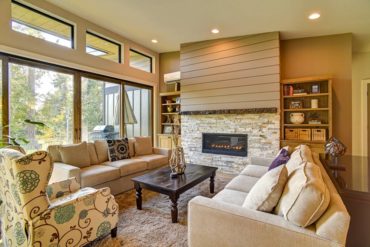 Janet Weber believes that the “fifth wall” — the ceiling — is becoming an important aspect in design. “The ceiling of your room can be painted, paneled, wallpapered or lit to create an illusion of height or just incorporate another design element,” she says.
Janet Weber believes that the “fifth wall” — the ceiling — is becoming an important aspect in design. “The ceiling of your room can be painted, paneled, wallpapered or lit to create an illusion of height or just incorporate another design element,” she says.
She says the open-concept house is being challenged by more closed-off spaces.
“I love the open concept but can see that people want to be able to close off certain areas of the house at certain times,” she says. “This involves a division of environments with natural elements like screens or sliding doors.”
Home offices are also evolving, no longer simply tucked away from the rest of the house.
“People are working more and more from home but they don’t want to be segregated,” Weber says. “They do want to be able to clean up easily and stash their work at the end of the day. This involves creative use of wall screens and mobile furniture overlapping leisure and work environments.”
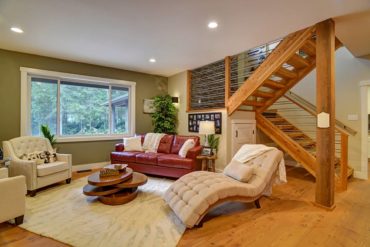 Colors: Benjamin Moore just named “First Light” its color of the year — a rosy pink that is light and airy. The Sherwin Williams color of the year is Naval, which is a rich, dark blue that is grayer than the original navy blue.
Colors: Benjamin Moore just named “First Light” its color of the year — a rosy pink that is light and airy. The Sherwin Williams color of the year is Naval, which is a rich, dark blue that is grayer than the original navy blue.
Green will be an important color this year in almost any shade. Behr’s color of the year is Back to Nature, a soft green shade. PPG’s color of the year is Chinese Porcelain, an orchid blue with violet undertones.
“I have also seen mint colors coming on strong already and I think that trend will continue,” she says.
Weber says that while color is coming back in a big way, those who went all in with gray shouldn’t be alarmed — gray is still a focus but in a warmer tone with less blue.
Counter surfaces: The recycled countertops are getting more popular. They use 100 percent recycled glass to create beautiful, one-of-a-kind countertops. Ultra-compact surfaces are also in demand — made from a blend of glass, porcelain and quartz, fused and compressed under very high pressure.
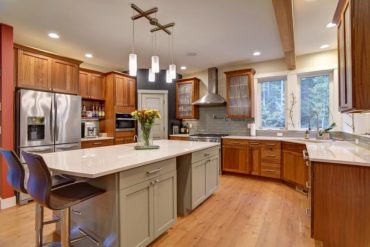 “This type of countertop has zero porosity, is heat-proof and almost indestructible. It is also extremely beautiful and different than any other countertop,” she says.
“This type of countertop has zero porosity, is heat-proof and almost indestructible. It is also extremely beautiful and different than any other countertop,” she says.
One of Weber’s personal favorites, soapstone, is making a resurgence of sorts for some people who love a natural material. “It does scratch but those scratches can be buffed out,” she says.
Fabrics: Polka dots, geometric designs and shiny metallic materials are trending, along with less realistic looking animal prints and organic patterns.
“I read that boucle fabric is coming back with ‘grandmother’ trends using lacey styles like raschel and anglaise,” she adds.
Floor coverings: It looks like carpeting is coming on strong in 2020. People are being drawn to the soft nature of carpeting. Hardwood flooring is still the most popular floor, or at least floors that look like hardwood. Luxury vinyl tile is still the most rapidly expanding floor in the marketplace. Parquet floors are making a comeback, as well as wood floors laid in a herringbone or angled pattern.
Dark colors for the floor are the “in” look, but blonds and whitewashed options are still popular. Environmentally friendly choices like bamboo, cork and engineered wood are also good options.
Furniture: The art deco style is coming back into vogue. Curves and organic shapes, smaller-scale furniture and modular furniture are also coming on strong.
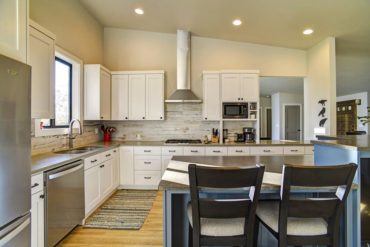 “Living spaces are getting smaller so furniture is getting smaller and more versatile,” she says. “Multifunctionality and sustainability are the buzz words in furniture for 2020.”
“Living spaces are getting smaller so furniture is getting smaller and more versatile,” she says. “Multifunctionality and sustainability are the buzz words in furniture for 2020.”
Some specific trends are black-steel, tubular designs and privacy chairs with high backs. There’s a trend using cane seats and backs on furniture and natural elements.
Lighting: Large-scale lighting pieces that create a focal point in the room will be popular in 2020. Neon is making a comeback, as well as linear and geometric shapes in light fixtures. Sconces are becoming more popular, especially as bedside lamps. Natural materials like wood, grass and burlap are big in the lighting industry.
“A personal favorite are the wood beads on chandeliers, basket pendants and burlap lamp shades,” she says.
The bare light bulb is on its way out, but clear pendants are still very popular. Gold and black finishes are the most popular but silver leaf is coming on very strong for next year.
Finishes: Weber loves penny tile, which is becoming very popular.
“It has such a unique look and comes in every color imaginable,” she says.
Matte and honed finishes are popular and more natural looking, and Weber is keeping an eye on leather tile, which looks amazing and wears well.
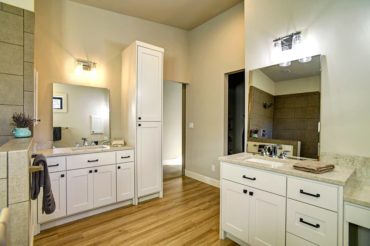 Windows and doors: Other trends include: Black frames are still popular but white frames will not be going out of style. Window screens are going away. You can still get them but people are opting out. Painted front doors are still very popular, especially blue.
Windows and doors: Other trends include: Black frames are still popular but white frames will not be going out of style. Window screens are going away. You can still get them but people are opting out. Painted front doors are still very popular, especially blue.
- Square and horizontal window shapes, especially in modern architecture
- Sliding windows used as doors
- Floor-to ceiling windows
- “Gridless,” which does not take away from the open feeling and light
- More glass and smaller frames in windows
- Corner windows
Window treatments: Curtains are coming back and motorization and home automation will be big in 2020. In keeping with the “green” movement, bamboo, woven shades and wood blinds are popular.
Green options: Reclaimed materials are huge and plentiful.
“I just sent away for leather floor samples and leather wall material made out of recycled belts,” she says. “The leather in the tile is all from recycled materials. I can’t wait to get these samples and see how I can use them.”
Another idea she saw was sustainable lamp shades made out of fallen leaves, made by Italian company Miyuca Design.
Her advice to the homeowner is to ask around and use social media to your advantage.
“People you know can give you recommendations for interior designers and general contractors to help with your project. Use this magazine for information as well,” she says. “I have a professional Houzz site and I use Houzz often to get ideas and see new products.”
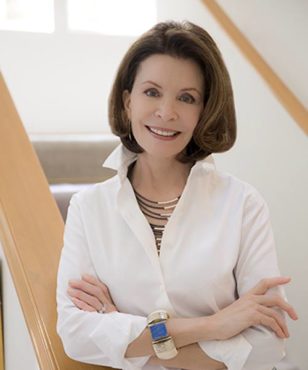 Kae Rosenberg
Kae Rosenberg
Kae Rosenberg Design
Seattle • 206-784-0117
kaerosenberginteriordesign.com
xnrebfraoret@pbzpnfg.arg
Kae Rosenberg Design & Consulting collaborates with clients, combining interior design and interior architecture to synthesize beauty and functionality into each project. It is always a bespoken reflection of its occupant. Rosenberg is a member of the local chapter of NKBA.
The overall trends that Kae Rosenberg is seeing include midcentury style, but she notes that her clients are trending toward “organic modernism.”
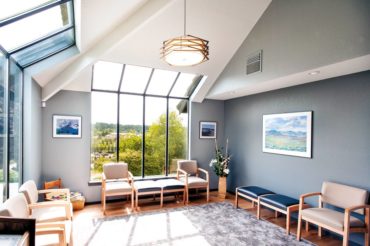 “There is also an ethnic trend that is building in the market-place and I think it will gain popularity in 2020,” she says.
“There is also an ethnic trend that is building in the market-place and I think it will gain popularity in 2020,” she says.
Other trends include:
- Neutral tones for colors, but with spots of saturated colors like leaf-greens, red-corals
- Quartzite countertops
- Durable, easy-care fabrics, paired with accent fabrics in luxurious textures and rich colors
- Engineered wood flooring with area rugs in natural fabrics
- Midcentury furnishings, along with a turn toward quality furnishings with “good bones” and clean lines that will stand the test of time
- Square, recessed lighting in 2, 4 and 6 inches, with 4-inch the most popular
- Blinds, both in fabrics and natural woven fibers, for window treatments, especially woven blinds in wood and reed
- Leather material for sofas and chairs
She also says that her clients are requesting green options, as well as universal design, without her suggesting it or “pushing” them in that direction.
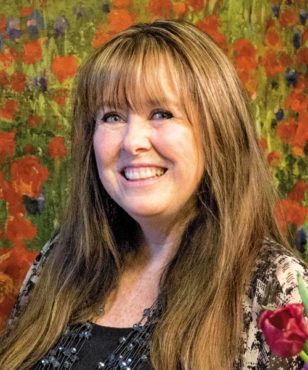 Connie LaMont
Connie LaMont
LaMont Design, Inc.
Poulsbo • 360-779-7227
lamontdesigninc.com
pbaavr@ynzbagqrfvtavap.pbz
Connie LaMont has been an interior designer and colorist in the Pacific Northwest since 1993. She holds a bachelor’s degree in arts from the University of California in Irvine and a second bachelor’s from the Interior Designers Institute in Newport Beach, Calif. LaMont and her architect husband, Wayne, own LaMont Design Inc. in Poulsbo. Some of their joint projects include Austin Towers in Poulsbo and Elkhorn Place in Sequim.
Connie LaMont says midcentury design is still trending like crazy. Sleek, tailored architecture is everywhere, and is being filled with furnishings that have that same sleek tailoring.
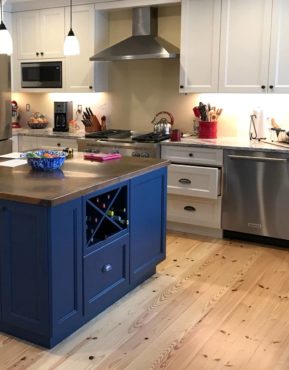 “Although the midcentury trend is strong, I see it paired with other authentic and vintage pieces that can soften the sometime-austere feeling connected with a minimalism interior,” she says.
“Although the midcentury trend is strong, I see it paired with other authentic and vintage pieces that can soften the sometime-austere feeling connected with a minimalism interior,” she says.
Colors: “Whites have been ‘cleansing’ our palettes for the last year or so, and we’re starting to bring back some boldness within our interiors to make a statement,” she says.
LaMont says navy blues, steel grays and blacks, saturated reds and teals have been strong elements but not always with just a wall. Some interiors have needed cabinetry, fireplace structures or large pieces of furniture like sofas to be the statement piece within the home. Soft sand and linen tones have become a backdrop for these statement colors. White trims and ceilings are most often her preference.
Counter surfaces: Countertops have become “functional art” within most homes in the past decade or so. Solid surfaces have taken the place of tile years ago, and the rule of thumb has become that the stronger the countertop surface, the better. Quartz and quarzite, along with granite and concrete, are still the most durable and beautiful countertops.
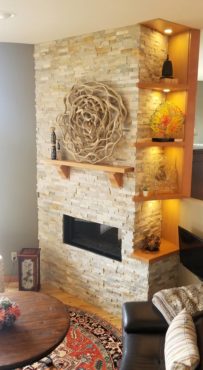 “In the right circumstance, I will still bring in some copper or slumped glass for some functional art,” she says.
“In the right circumstance, I will still bring in some copper or slumped glass for some functional art,” she says.
Fabrics: Natural, textural fabrics are the most interesting and luxurious, but not always the most durable. Sunbrella knockoffs, like Perennials fabric, are wonderful; and furniture from Crate and Barrel, Pottery Barn and Restoration Hardware have delicious fabrics to chose from that look and feel like linen or silk but hold their shape and have longevity for your investments.
Floor coverings: LaMont has been a fan of luxury plank vinyl since it was called commercial-grade vinyl year ago.
“I love the durability, as well as all of the beautiful styles and sizes that it now comes in,” she says. “It not only looks like wood, but it sounds like wood, too. We can have the luxurious, warm look of wood, but it can be in our kitchens, bathrooms, and laundry rooms, as well as our entries, with all but no maintenance.”
Furniture: Sectionals are still a great choice to bring into any great room or family room. It gives seating for two, with the option for many. Another good choice for these spaces would be a pair of two-seaters, known as love seats, in conjunction with at least two swivel chairs, known as barrel chairs.
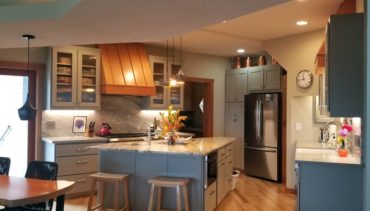 “Seating for two, with the option for many, is a great way to plan your furniture purchases,” LaMont says.
“Seating for two, with the option for many, is a great way to plan your furniture purchases,” LaMont says.
Lighting: Light fixtures are more and more an art form. With the trend of midcentury design, light fixtures became even more of a statement piece than in years past.
“I encourage my clients to notice ‘what stops them in their tracks’ when they are looking at lighting, as well as other details within their homes, like furniture, artwork, etc. If it actually stops you in your tracks, it most likely will continue to bring you joy in the years to come,” she says.
Finishes: Finishes that are either shimmering (not shiny) or textural.
“And if a piece of furniture, a light fixture, a tile for your backsplash has both of these elements, it’s a win-win situation,” she says.
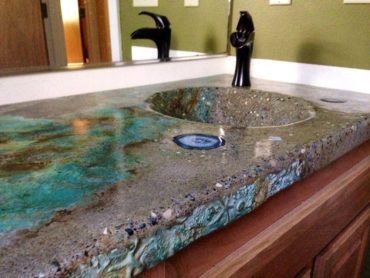 Windows and doors: Tall and tailored doors and windows are becoming the norm. And if your budget isn’t allowing for the 8-foot height (that is also becoming the norm), then having a transom window above your doors and windows (depending on your architectural style) is a way to bring the elongated vertical height within your interiors. Simple trim on both the interior and exterior of your home is also trending.
Windows and doors: Tall and tailored doors and windows are becoming the norm. And if your budget isn’t allowing for the 8-foot height (that is also becoming the norm), then having a transom window above your doors and windows (depending on your architectural style) is a way to bring the elongated vertical height within your interiors. Simple trim on both the interior and exterior of your home is also trending.
Window treatments: Roller shades, sometimes referred to as solar shades, have been her “go-to.” They allow the view to be unobstructed but control the amount of sunshine and privacy within homes.
“More and more of my clients are creating outdoor living spaces. Whether it’s new construction with a purposefully designed covered porch, or if it’s done with a patio cover over an existing uncovered porch, clients are enjoying the mild seasons here in the Pacific Northwest by adding outdoor propane heaters and fire tables,” she says. “The same use of roller shades (aka solar shades) is a great application on the exterior as well as the interior.”
Natural materials: There are still great applications for natural, live-edge wood. Lightweight concrete is a beautiful and durable countertop surface for kitchens and baths, as well as mantels and walls.
LaMont’s advice to the homeowner is to do an online search for professionals in your area, whether it’s for an interior designer, architect, builder, etc.
“You can take a look at their website to see some of their projects, and not be pressured,” she says. “Then if you like what you see, you can give them a call or pop them an email.”
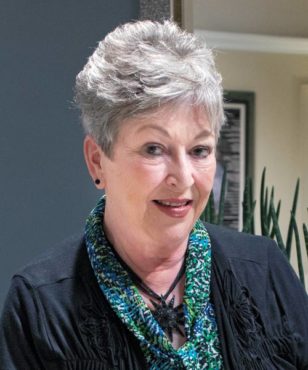 Cate Adams
Cate Adams
Arnold’s Home Furnishings
Bremerton • 360-377-5582
arnoldshomefurnishings.com
Cate Adams has a degree in art and design from the University of London and has worked in London, Paris and Spain. Adams eventually settled in the Pacific Northwest. She currently serves as an interior designer with Arnold’s Home Furnishings. She lives with her husband, Jack, in Silverdale.
Cate Adams says that casual finishes and materials continue to dominate home interiors this year. Woods ranging from white oak and maple to acacia and mango have lower sheen and wire-brushed finishes, highlighting grain patterns and giving pieces a tactile appeal.
Colors: Lighter taupe tones, contrasting with darker woods or metals, have replaced some of the grays that have dominated in recent years. But no worries to recent buyers, she adds — grays are not going away anytime soon.
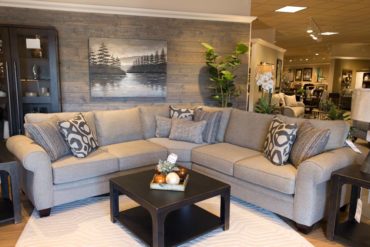 Finishes: Consumers have probably noticed the introduction of many mixed metals — iron, brass and copper are popping up everywhere as accents.
Finishes: Consumers have probably noticed the introduction of many mixed metals — iron, brass and copper are popping up everywhere as accents.
Fabrics: The “super” fabrics are being requested more and more.
“About 95 percent of our incoming fabrics are 100 percent polyester,” she says. “We see it in velvets, ‘cottons,’ textures, brocades and linen looks. Polyester wears well and cleans well — it’s ideal for home furnishings.”
Furniture: Contemporary sofas with track arms are very popular, as are sofas with attached chaises. Navy blue, teal, aqua — in fact, all shades of blue — continue to dominate. There are lots of novelty pillows, such as puppy prints, being seen on the solid, larger pieces.
Almost all the newer motion pieces are coming in with power controls.
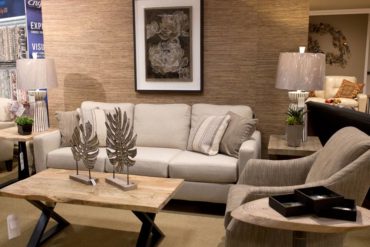 “Many consumers are intimidated by this, but they are available with rechargeable batteries for situations where the furniture needs to float, and the furniture actually lasts longer as the frames are not taking a continual racking motion,” Adams says. “There are now an amazing variety of positions and options on the control panels, with head tilt and lumbar support increasingly common. The recliners and lift chairs cater to a multitude of health problems and are simply extremely comfortable.”
“Many consumers are intimidated by this, but they are available with rechargeable batteries for situations where the furniture needs to float, and the furniture actually lasts longer as the frames are not taking a continual racking motion,” Adams says. “There are now an amazing variety of positions and options on the control panels, with head tilt and lumbar support increasingly common. The recliners and lift chairs cater to a multitude of health problems and are simply extremely comfortable.”
Lighting: Floor lamps take on multiple tasks with reading lights and up lights in one. Mixed metals, ceramics and glass lamps add shine and pop to all spaces.
Other details: Accessories such as oversized art pieces and patterned area rugs look wonderful with large, solid pieces, and they bring life to a room.
Faux plants are also a huge plus. They add fluff, curves, softness and greenery to rooms that are generally angular.
“The silks have improved dramatically in recent years and are no longer a sign of failure and embarrassment to those of us with purple thumbs,” she says.
Her advice to those in the decorating mood is to ask for help if you are floundering.
“A new look for your space need not be expensive, but if larger pieces are necessary, you don’t want to make a mistake,” she says. “Have fun and add some color.”
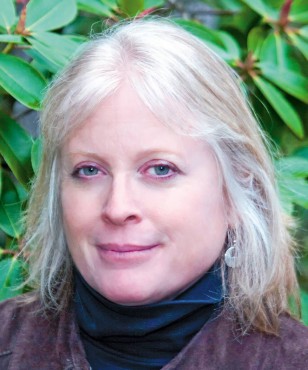 Nancy Finneson
Nancy Finneson
DeMane DESIGN, LLC
Gig Harbor • 253-973-8442
demanedesign.com
anapl@qrznarqrfvta.pbz
Nancy Finneson, AKBD, CAPS, CLIPP, Allied ASID, is an award-winning interior designer and kitchen and bath designer. She attended the Art Institute of Chicago and later received a degree in interior design. She is a certified associate kitchen and bath designer with the National Kitchen and Bath Association, a certified aging in place specialist, certified living in place professional and an allied member of the American Society of Interior Designers. After spending many years in the San Francisco Bay area, Finneson now makes her home on the beautiful Puget Sound. She loves working with people and enriching their lives by helping create spaces that inspire, entertain and function brilliantly. One of her favorite projects has been adopting and creating a room for the new YMCA domestic violence shelter in Tacoma. Recently she was honored with three first-place and one second-place awards for design from the prestigious American Society of Interior Designers.
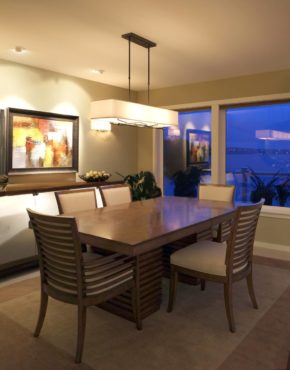 Nancy Finneson says that the challenge of designing the modern home has evolved. The large, mini mansions are few and far between.
Nancy Finneson says that the challenge of designing the modern home has evolved. The large, mini mansions are few and far between.
“We consider how much space do we really need and want, with the thought that we don’t want to be wasteful or extravert at the environment’s expense,” she says. “The balance is a happy medium that I discuss with clients and requires creative design solutions. Our homes area a place to rest, entertain and handle our daily activities. The design needs to include space for work and inspirations.”
A must-have are “gathering” areas throughout your home, places where people can gather and converse — seating in the kitchen; a banquette, a table or stools at the counter.
“In the living/family room, make sure you can face each other with sofas and chairs. Swivel chairs make it easy, and an ottoman is also great because it can be moved around with little effort,” she says.
This year is about geometric balance and not overdoing it. “We are on overload; patterns being seen in design in our households are everywhere: tiles, wallpaper, flooring, fixtures, bedding and dishware, to name a few. Be strategic and selective on how much works in a room,” Finneson says.
Colors: A slash of paint can make or break a room. Color forecasts for 2020 range from soothing to bold. For a soothing look, try Benjamin Moore Crystalline and First Light (a neutral pink that is really more of a neutral rather than pink), and Sherwin Williams Misty. More dramatic hues are Sherwin Williams rich Granite Peak and Benjamin Moore’s Cushing Green.
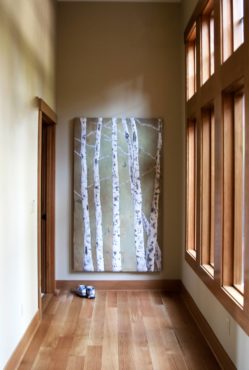 “Most of my clients gravitate toward neutral pallets for walls, seeking out color with accents with pillows, window treatments and accessories,” she says. “To offset quiet paint colors, highlight with a different color — think shades of charcoal, deep blues or greens. If you’re not afraid of color, give it an edge with deep tones; they can give a cozy, secure feel to a room.”
“Most of my clients gravitate toward neutral pallets for walls, seeking out color with accents with pillows, window treatments and accessories,” she says. “To offset quiet paint colors, highlight with a different color — think shades of charcoal, deep blues or greens. If you’re not afraid of color, give it an edge with deep tones; they can give a cozy, secure feel to a room.”
Counter surfaces: Engineered quartz is still the preferred countertop material over granite and stone. Many engineered quartzes mimic natural veining that is organically seen in certain marbles and granites. Veining patterns are dominating the market and will continue next year. They range from striking dramatic to subtle, most often in whites with veining in gray, tan or black. For a more dramatic look, white veining on black is also popular.
“Don’t rule out natural stones,” she adds. “I’m excited to see that quartzite, a natural stone that is harder than granite, is available. It has a natural beauty and depth, but don’t confuse it with manufactured quartz surfacing or marble.”
Another popular countertop surface made by Mother Nature is soapstone. It has a nice feel and touch and is naturally heat-resistant and chemical-free.
“When selecting, no matter what material you use, always try to see a full-size slab,” she advises. “Small 4-by-4 samples don’t always represent what your countertop may look like.”
Fabrics: Textures in fabrics with a focus on velvet and boucle are coming in 2020. Boucle is not flat but instead is a raised curled/looped yarn.
“Many may associate the fabric with Coco Chanel’s iconic boucle tweed jacket. However, 2020 will update that look with new colorways and uses,” she says.
Velvets and velvet textures are in the living room on sofas and in the bedroom with bedding. Velvets are vibrant in blues, burnt orange and shades of taupe.
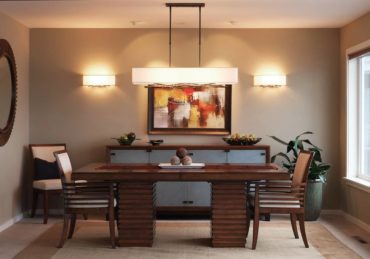 Wall coverings have made a comeback with great textures and bold patterns, and options are endless and amazing. Three-dimensional wall coverings are seen across the globe with detailed patterns in bold colors. There are the classic materials like grass cloth, but now they are stained in lovely colorways like deep blue or pewter.
Wall coverings have made a comeback with great textures and bold patterns, and options are endless and amazing. Three-dimensional wall coverings are seen across the globe with detailed patterns in bold colors. There are the classic materials like grass cloth, but now they are stained in lovely colorways like deep blue or pewter.
“The materials used have improved dramatically, giving us more options for placement without feeling like we’re taking a risk,” Finneson says. “Use it in any room in your home, entries, mud rooms, laundry rooms, kitchens, bathrooms, a den or living room.”
Floor coverings: Finneson looks for trends that she believes will have longevity in the marketplace. Elongated planks made a big splash a few years back and are here to stay. For a comfortable presentation with wood, go with 6- to 8-inch wide and 24- to 48-inch-long planking. Matte and satin have replaced high-gloss finishes.
Dark floors have become less popular. The gray tones are in their own grouping, still on trend and widespread. Lighter woods, with wide planks, tend to make a room feel larger and more open and casual. Darker woods tend to make a space feel more traditional and formal. In both cases, it all depends how you dress the space with furnishings and the architecture of a home.
Patterns in flooring is a huge hit. Chevron and herringbone patterns are similar, with the later being less expensive to install. “Laying flooring in diagonally will modernize your home, but does cost a bit more with material and labor,” she says. Wirebrushed and distressed finishes are also current. They have the benefit of not showing dust and dirt as readily as a flat finish, making it popular for busy lifestyles.
Carpets and area rugs with character are still strong in the design corner. Character is the key — think bold patterns, not necessarily bold colors. Low-pile heights are popular, as they are easier to clean and you don’t see marks when moving furniture such as dining chairs. Statement area rugs set the tone for the home. Size matters, so make sure the carpet fits the area you want to place it in; bigger is always better. A carefully selected carpet will add luxury and is an investment to be enjoyed.
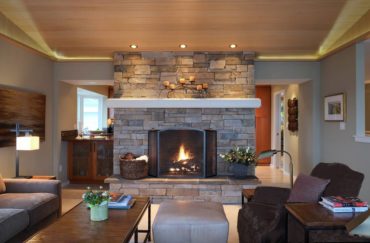 Furniture: No more grouped sets of furniture. If you want a space to look curated and unique, make sure you blend new with old, introduce different styles that complement each other. In the bedroom, four-poster and canopy beds are coming back, but they are modern and simple with slender framing.
Furniture: No more grouped sets of furniture. If you want a space to look curated and unique, make sure you blend new with old, introduce different styles that complement each other. In the bedroom, four-poster and canopy beds are coming back, but they are modern and simple with slender framing.
Lighting: Choose bold lighting and make it the focus of a room. This year, pendants and chandeliers in organic and geometric shapes are present. Geometric shapes have a modern flare with circles, spheres and squares in glass or framed in metals. Organics can look like hand-blown droplets of water in varied sizes and color. Shade materials are going natural with burlap, basket weaves and tree bark.
Sconces with swing arms are also finding to be useful and add style in bedrooms, casual rooms and kitchen nooks where directional lighting is a plus. Recessed lighting is still a favorite because of its diversity of function. It can accent art or illuminate a room with a minimalistic look that is uncluttered.
“The use of a combination of lighting — natural, ambient, task, accent and task lighting — make a space livable, comfortable and pleasing to be in,” she says.
Light strips, most commonly used as undercabinet lighting in kitchens, are being used more all over the home inside and out. All offer functional and decorative elements in areas such as toe kicks, under wall-hung cabinetry (like a vanity in a bath), the edge of a countertops, steps on a staircase, in bookcases and shelving, cove ceiling moldings, incorporated in the railing on decks and interiors.
Finishes: Finishes that are trending in metals are gold tones, not brassy gold, but brushed and refined. An example is gold hardware that can accent well with most wood tones and is wonderful with painted hues of blue, charcoal and black. Black as an accent color in hardware and fixtures is very much a part of the new standard.
“It can accent cabinets and tile wonderfully, just remember to not overdo it,” she says.
Windows and doors: Let the light in with windows, doors and skylights. Any space where you can add natural light makes Northwesterners with our gray days happy and joyful. In kitchens, many are forging wall cabinets and replacing them with windows. The lost storage is replaced with better, more accessible and organized storage.
Skylights and light tunnels are high on home improvements. They can also make a small space feel larger, not closed-in, and give ventilation without compromising privacy. They are being added in entries, hallways, small bathrooms, stairwells, offices — the list is endless.
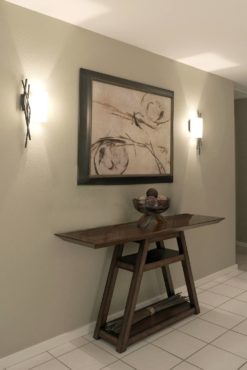 “One consideration with skylights is determining if you may require a shade — if so, I advise you do it at installation,” Finneson says.
“One consideration with skylights is determining if you may require a shade — if so, I advise you do it at installation,” Finneson says.
The barn-style door is still being embraced in remodeling today. It can be used in many places: closets, bedrooms and pantries, and dividing spaces like the dining room from a family room. Door hardware ranges from modern to rustic. The door panels range just as much as hardware styles, with decorative panels such as carved wood or metal grillwork. If used in a space that would enjoy light, defused glass panels work well.
Window treatments: Window treatments are all about motorization. Technology with the ability to raise and lower shades, blinds and drapes through a remote, your phone or tablet is here to stay. Power can be supplied with batteries, or when remodeling, talk about the option of shades in the planning stage, as hard-wired power is most efficient.
“Child-safe products are not a trend, but each year, there are more cordless offerings to keep us safe,” she says.
New green options: New life comes from previously discarded products. Leather floor tiles can be very green, and some manufacturers are making them with leftover scraps from furniture and shoes retrieved from tanneries. Bio-glass, another green product, is 100 percent postconsumer recycled glass that is made into countertops. Coco decorative tiles are new to the market. They are made from the leftover coco bean shells.
“Homeowners are more aware of the environment and willing to take the extra step to assure how they live reflects their beliefs,” she says. “We now can recycle in style in the kitchen. There are many recycling centers/drawers that pull out with the touch of your knee or finger, allowing for easy access. Composting kitchen waste can now be directly swept away into a recessed sealed bin in your countertop.”
Natural materials: More natural woods and shapes are used in furniture, like a branch or log table base. Basketry and wicker are fresh and alive, and it’s not painted white as in the past. Bamboo, which is a quickly renewable resource, is being used more in fabrics, especially linens and towels. It can be amazingly refined and soft when processed.
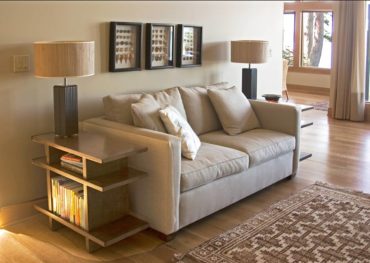 Her advice to homeowners is to create a “sense of place” — determine what makes you feel good when you walk into a space. For example, think what excites you in terms of color, then try to incorporate it in small doses throughout your home, giving it a connected flow. Another tip is to pay attention to scale in regards to furniture.
Her advice to homeowners is to create a “sense of place” — determine what makes you feel good when you walk into a space. For example, think what excites you in terms of color, then try to incorporate it in small doses throughout your home, giving it a connected flow. Another tip is to pay attention to scale in regards to furniture.
Make a space cohesive by collecting pieces that complement each other without being “matchy.”
“Don’t be afraid to pare a modern sofa with a vintage table to create some variety,” she says.
Less is more. A cluttered space doesn’t generate calm. Be selective with what you display.
“Layer contrasts with texture in a room. Look at things not just by color or size, but by how they feel (rough and soft),” Finneson says. “Accent pillows in a variety of fabrics and shades can add depth to a room. Consider using different materials such as metals, wood, glass, woven goods or soft fabrics.”
And don’t be afraid to seek assistance. Collaborating with a designer can help make your design dreams come to reality.
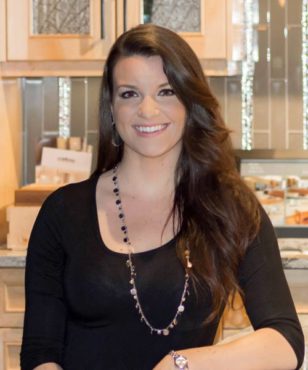 Natalie Collins Shaw
Natalie Collins Shaw
Kitsap Kitchen & Bath Co.
Poulsbo • 360-697-5616
kitsapkitchenandbath.com
Natalie Collins Shaw was born and raised on Bainbridge Island and has known her path in the kitchen and bath industry from a very young age. Growing up on jobsites with her father, Jim Collins, who was a custom home builder in the Kitsap area, made her fall in love with not only the beautiful finished products, but every phase of the project and everyone involved to make the client’s dreams become a reality. Shaw has been working at Kitsap Kitchen & Bath Co., her family business, since 2015 and is the company’s lead designer. Whether the project is big or small, balancing aesthetically pleasing elements with functionality is the key to good design. Her style stems around timeless design, creating a look that will last decades. Her goal is to provide each and every one of her clients with an experience that is comfortable, energizing and ultimately a newfound love for their home.
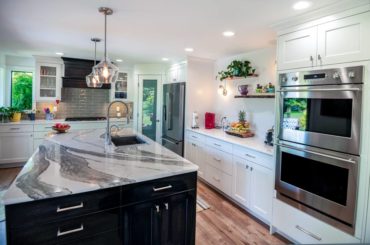 Natalie Collins Shaw is noting elements from the roaring 1920s — art deco, peacock green, metallic gold and marble accents. There are also Southwestern vibes — warm soil colors with a dusty hue, teals, textile patterns traditional to the Native American cultures and a mix of stone and rustic wood. Additionally, the modern farmhouse is trendy — taking the classic home on the farm and giving it a bit more contemporary/industrial flare.
Natalie Collins Shaw is noting elements from the roaring 1920s — art deco, peacock green, metallic gold and marble accents. There are also Southwestern vibes — warm soil colors with a dusty hue, teals, textile patterns traditional to the Native American cultures and a mix of stone and rustic wood. Additionally, the modern farmhouse is trendy — taking the classic home on the farm and giving it a bit more contemporary/industrial flare.
Counter surfaces: Quartz has been leading the industry with its beauty and durability. The nonporous quality of quartz countertops truly makes care and maintenance easy as can be because it will not scratch, stain or need to be resealed after fabrication. Cambria Quartz and HanStone are both fabulous North American companies with designs to suite anyone’s taste.
Floor covering: The luxury vinyl tile sector of the flooring industry has really been making moves.
“There are some very lovely options made to look like stone or wood, extremely durable when it comes to the heavy traffic areas and pets in the home, and suitable for wet locations (bathrooms, laundry rooms and so on) as an alternative to natural stone or porcelain tile, with prices per square foot generally less than $5. Durable and economical,” she says.
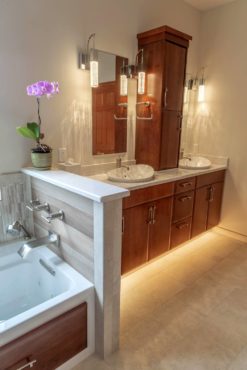 Lighting: Shaw has been noticing a surge in the industrial chic style of fixtures. Mixing of metals, but primarily the use of dark bronze and either copper or brass accents.
Lighting: Shaw has been noticing a surge in the industrial chic style of fixtures. Mixing of metals, but primarily the use of dark bronze and either copper or brass accents.
“Shapes vary depending on the fixture type and location; the industrial chic style generally has a comforting look, simple lines and connect us to vintage times,” she says. “This is truly a versatile look; you could live in an urban environment or out in the country — either way, this is a style that connects us back to the past.”
Finishes: Again, the industrial chic plays a large role with finishes. Dark bronze, matte black and accents of copper or brass.
Natural materials: The material that has been catching her eye under the natural material category is the large porcelain slabs used in seamless shower designs.
“Yes, 100 percent natural materials. Porcelain is durable and provides looks from gorgeous natural veined to metallic and industrial,” she says. “This material can be used as countertops, wall treatment and even flooring. If you haven’t seen these large porcelain slabs, I would highly suggest looking into it, especially for a stunning shower. Infinity is an Italian company I highly recommend.”
Her advice to the homeowner who needs advice is to contact a local remodeling company to discuss any questions or concerns before diving into a full project.
“If you are more of an online researcher, Houzz.com has wonderful ideabooks, articles and the ability for you to contact local professionals,” she says. “If you are unsure of how to find trade professionals, your local chamber of commerce or home builders association can also provide you with contact information.”
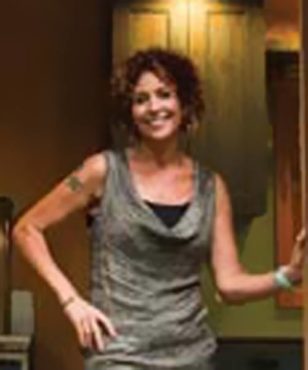
Brett Marlo DeSantis
Brett Marlo Design Build
Gig Harbor • 253-376-7935
brettmarlo.com
Brett Marlo DeSantis lives the tiny life in the Great Pacific Northwest and loves it. She has a master’s degree in interior architecture and design, is a LEED accredited professional with a specialty in building construction and design, and is Living Future accredited. She believes in continuing education and staying on top of trends (even better, she stays in front of them). DeSantis owns and operates Brett Marlo Design Build.
Brett Marlo DeSantis sees a move back toward smaller homes and backyard “auxiliary dwelling units.”
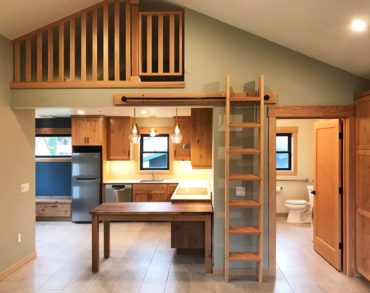 Things that she sees as trending include:
Things that she sees as trending include:
- Site-specific color palettes like coastal, inland, urban, rural etc.
- A move back to more resilient surfaces such as wood, laminate and eco-friendly composites
- Fabrics that use Earth-friendly dyes, materials and processes
- Wood, tile and linoleum floor coverings
- LED lighting that doesn’t feel “LEDish”
- Multi-use, salvaged or rethought family pieces for furniture
- Windows and door styles that are smaller scale with repetition, and a shift from cheap and toxic vinyl
- Window treatments from woven, nature-inspired fabrics
- Locally made tiles, sourced wood and hemp for materials
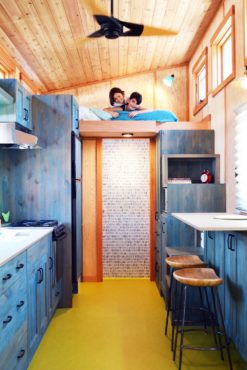 She describes the finishes that are currently prevalent as “conscious consumerism.”
She describes the finishes that are currently prevalent as “conscious consumerism.”
“Designers and clients are considering the true length of durability and specifying the right material for the desired length, maintenance and look,” she says.
Her advice to homeowners is to look online as a starting point to spur inspiration.
“When you are ready to make those design musings a realistic vision in terms of scale, function and cohesive design, seek a design professional,” she says. “Even a small consult can let you know if you are on track.”
 Deann Hammer
Deann Hammer
Broadway Design
Gig Harbor • 253-224-5133
broadwaydesign.net
broadwaydesign [at] comcast [dot] net
(Deann Hammer photos courtesy Brett Wayne Photography)
Deann Hammer, owner of Broadway Design, is a lifetime Gig Harbor resident. Her company has been serving the Puget Sound area with stunning interiors since 1999. Her accolades include “Best Interior Design” Pierce County Street of Dreams, and being featured in Architectural Digest as one of the “Top Leading Designers” of Seattle. Hammer combines her strong creative mind with a 20-year background in the construction industry as a general contractor. She has designed and decorated single and multifamily projects from Seattle to as far as Costa Rica. Her mission is to create unique homes for clients that are a reflection of their natural surroundings, and make a bold statement about the people who live inside them. Every project speaks for itself and is a one-of-a-kind art form.
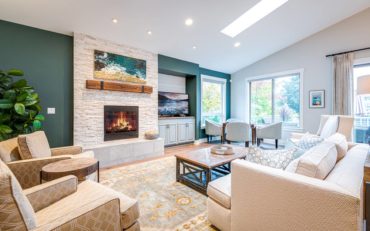 Deann Hammer says there’s a resurgence of design trends from the 1970s and ’80s. That includes brass, bursts of color like hot pink and aqua, with lime and avocado green, as well as macrame plant hangers and textured wallpapers (like grass cloth).
Deann Hammer says there’s a resurgence of design trends from the 1970s and ’80s. That includes brass, bursts of color like hot pink and aqua, with lime and avocado green, as well as macrame plant hangers and textured wallpapers (like grass cloth).
“The pendulum has swung away from all of the cold, cool grey, as well as barnwood and Texas shabby chic. Now we are seeing any leftover grey and white balanced with warm-colored hardware, warm tones in lighting and colorful carpets bringing a burst of life back into the design equation,” she says.
Moroccan influences are still emerging in tile, carpet, furniture and lighting.
“These intricate patterns and textures make a home come alive,” Hammer says.
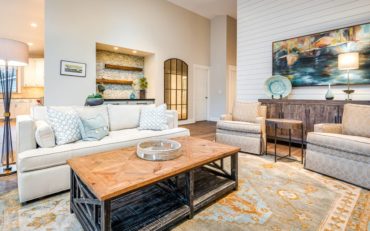 Lighting is becoming the jewelry of the home, no longer just a performer of light. Trends include decorative pendants dropped in the corner of a bath or another unexpected place, and wall sconces flanking beds instead of lamps.
Lighting is becoming the jewelry of the home, no longer just a performer of light. Trends include decorative pendants dropped in the corner of a bath or another unexpected place, and wall sconces flanking beds instead of lamps.
Hammer sees homeowners downsizing their furnishings, which are not only smaller in scale but also have clean lines.
“Velvets and rich colors are hip, and often paired with bright pops of colors,” she says. “We may see a cobalt-blue velvet chair paired with a pink-and-lime-green pillow, for instance. Not everything is bold, but putting something like this in a room with a neutral sofa sectional and a camel-colored leather, open-armed chair with a fur rug is unexpected and whimsical. Think boho chic. Texture is paramount.”
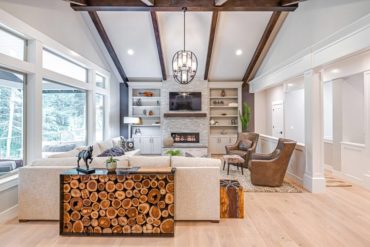 Wood is still attractive, she says, but there’s less rustic barn wood and more exotic woods that have live edges and richer color. Koa wood, walnut and other exotic hardwoods that are sanded to a smooth, glossy finish are leading the pack. Wall wood panels are trending but are separated with Schluter metal strips to bring back that “Mad Men” ’70s vibe and add warmth and texture to walls instead of a sea of drywall. Ship lap and batt and board is also still popular, depending on the style of the home.
Wood is still attractive, she says, but there’s less rustic barn wood and more exotic woods that have live edges and richer color. Koa wood, walnut and other exotic hardwoods that are sanded to a smooth, glossy finish are leading the pack. Wall wood panels are trending but are separated with Schluter metal strips to bring back that “Mad Men” ’70s vibe and add warmth and texture to walls instead of a sea of drywall. Ship lap and batt and board is also still popular, depending on the style of the home.
Countertops: Quartz is still at the top of the list due to its durability and availability in light colors, but there’s also the emergence of rich woods used in kitchen islands and other accents, such as shelving and wood-tub surrounds.
Flooring: Floor coverings are gaining popularity for their performance over appearance, and luxury vinyl tile and engineered hardwoods are preferred over real wood that scratches and dents. Wide plank is still popular and often with some sort of distressing or dramatic wood grain. Lighter-colored floors are becoming more popular, as they do not show dust and dirt as much as darker floors do.
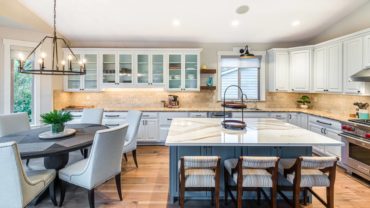
Windows: Black metal windows are trending, with thin mullions and often grid patterns added. They allow the homeowner to see “through” them more than a white vinyl window does, and greatly impact the look of a home by adding luxury and light to any space.
Window coverings: Heavily curtained windows of the past are gone. Now roller shades made from natural materials such as woven grass or plastic woven to look like grass cloth are trending. These add texture to a bare window and are easily rolled up out of the way, creating a clean, attractive valance when not in use.
Hammer recommends hiring a professional if you are considering building or renovating.
“Those of use who work in the industry know how to source the best, highest-performance materials so you are not replacing them shortly down the line. We also know where to find the greatest values on building products and furnishings,” she says. “In the end, you can’t afford not to hire a professional. The mistakes you will save yourself will easily make up for the small design or construction fee you will pay.”
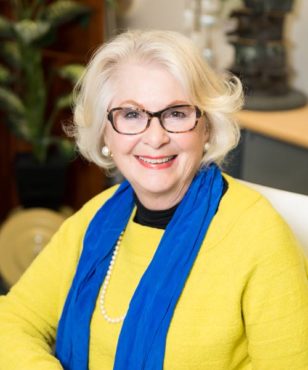 Eleanor Olsen
Eleanor Olsen
Total Spaces Design
Port Ludlow • 206-713-2869
totalspacesdesign.houzz.com
rbyfra9218@pbzpnfg.arg
Eleanor A. Olsen, AKBD, is the owner of design/build firm Total Spaces Design and an accomplished award-winning interior, kitchen and bath designer and general contractor with more than 30 years of experience. Her projects have been published numerous times nationally and internationally. Olsen studied at Parsons School of Design in New York and Paris. She is the current president of the Olympic West Sound Chapter of the National Kitchen & Bath Association.
Eleanor Olsen says the major trends she sees are green, renewable products — they are very popular and will continue to gain as more and more people become aware of how their personal choices can impact the planet.
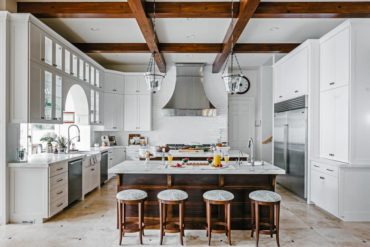
Colors: Soft, grayed-down pastels have been used more in the past year. Strong, saturated blue cabinets are still going strong. Using black to add grounding to white-painted cabinets has really taken a foothold in the design world. It gives a strong contrast of color blocking that is popular right now, including in the fashion world.
“Do remember though when using this combination, high contrast takes up more space visually, so be judicious in the use of black and white,” Olsen says.
Counter surfaces: Quartz products are dominating most projects, like silestone, but quartzite (a natural stone) is beginning to surge forward.
Fabrics: Textured, natural fabrics, especially linens with interesting weaves using tonal qualities to add interest. They’re wonderful as soft flowing, yet tailored window treatments.
Floor coverings: Natural, green products are trending. Tiles for kitchen and bath are very on trend still.
“I have noticed more choices in textured floor tiles to help prevent slipping when used in wet areas,” she says. “My favorite flooring product right now is an easy-to-install, click-together cork because it is a very renewable product, wears well and is easy underfoot. A big bonus is that cork adds to the textured layering, giving so much interest to a space.”
Furniture: Classic, well-tailored lines that are clean, angular, crisp and uncluttered with a traditional Scandinavian influence continue to be strong. There are also several choices that incorporate a curved line here and there to soften the look, giving it a combination of the masculine and feminine appeal. Metallic details in home furnishings to highlight a special accent piece are on the uptick. Globally inspired Moroccan looks are gaining momentum and fit right in with your Bohemian-inspired fabrics.
Lighting: LED ties in with the green influence, but more sophisticated LEDs that are dimmable without flickering. No 4- and 6-inch, full-size cans — just minis. Smart lighting is becoming easier to use and what was once just a luxury is becoming a standard practice.
Finishes: Chrome and polished nickel have always been classic and she continue to use them, Olsen says.
“However, I am loving the soft bronzes or brass tones that we are seeing in hardware and plumbing products now,” she says. “It is OK to mix it up a bit too; you don’t have to have all one metal throughout your home. Just make sure there is a way you are bringing it all together, so it doesn’t look like a random decision.”
This can be as simple as having an accessory, like a two-toned metallic lamp that combines the two finishes like brass and chrome over a blackened steel. Then you might add a mirror with a soft brass frame, and use oil-rubbed bronze door hardware.
“When you think about it, the mirror could tie in with chrome, nickel, silver and pewter,” she adds. “As long as you are being mindful of what you are putting together, mixing finishes will work well. This is one of the ways you achieve a curated look of collections brought together that are uniquely your own.”
Windows and doors: Her favorites are casement windows with mullions at the top third. The upper divided light adds interest, while the lower two-thirds keeps the views clear and unobstructed.
“I like the durability of fiberglass-clad wood windows to hold up best near salt water, and we certainly have lots of salt water areas in the West Sound,” she says.
Olsen’s favorite doors are solid wood, painted in shiny, bold hues that pop against the siding and trim color. The styles are clean lines, uncluttered and crisp. Windows and sidelights have clean, straight lines.
“Don’t forget the extras when getting your window package,” she advises. “Tints that cut UV rays and protect your fabrics and woods from fading are worth every penny. However, it is not too late if you have your windows already. Tinted films and even frosting can be added any time. There are also window films that protect against breakage.”
Window treatments: She likes the clean lines of a tailored fabric shade to control light and offer privacy. Living, dining and other family gathering places are always served well with floor-to-ceiling, tailored curtains that soften the space and have the added benefit of noise absorption. Additionally, with an insulated lining, you can keep out cold in the winter and excessive heat in the summer.
Natural materials: Wood and quartzite for countertops, as well as wonderful linens, are trending.
Olsen’s advice for homeowners is to seek out professionals with credentials, like members of the National Kitchen & Bath Association.
“NKBA members are constantly continuing their professional development by learning about the latest code, new products, updates on best practices, as well as issues that are of concern, like the benefits of specifying sustainable products, and how to best protect the health safety and welfare of the consumer,” she says.
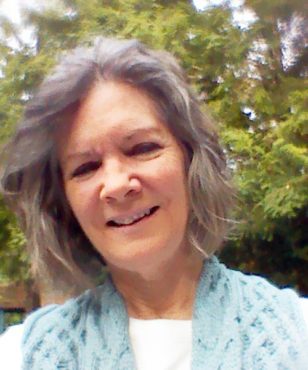 Tracy M. Corriveau
Tracy M. Corriveau
Corriveau Interiors Kitsap
Kingston • 360-860-1052
corriveauinteriorskitsap.com
genpl@pbeevirnhvagrevbefxvgfnc.pbz
Tracy M. Corriveau has a bachelor of arts in interior design from Michigan State University, and postgraduate studies in architecture and interior design at the University of London, England. She has over 30 years of experience in both residential and commercial interior design, lighting design, interior design instructor at NW College of Art in Poulsbo, and residential real estate sales in Kingston. She has lived in the North Kitsap area since 1982. Corriveau has certifications with the National Association of Home Builders: CAPS Certified Aging-in-Place Specialist, and CGP Certified Green Professional and is a member of Kitsap Builders Association and National Kitchen & Bath Association. Her focus for award-winning designs is on functionality, safety, accessibility, low-maintenance materials and best practices.
The overall trends that Tracy M. Corriveau sees include large-format tiles and tone slab in the showers, for less grout maintenance.
Other trends include:
- Whites and grays for colors, with some additional black and dark grays coming in
- Quartz and quartzite counter surfaces
- Luxury vinyl tile or sheet goods for floor coverings
- Midcentury modern furniture
- More LED pendant choices available in lighting
- Shaker doors
- Shades with light control for window treatments
Her advice for the homeowner is to check with professional organizations, such as your local home builders association (KBA), Houzz and National Kitchen & Bath Association (NKBA).
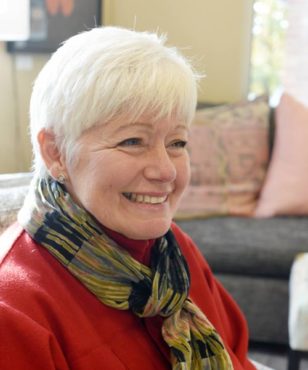 Mary Terry
Mary Terry
Furnish Bainbridge
Bainbridge Island • 206-780-8399
furnishbainbridge.com
vasb@sheavfuonvaoevqtr.pbz
Born on Oklahoma, Mary Terry moved to Bainbridge in 1979 with her husband, Frank Childers. Always maintaining a design and sewing business, she was at home with her three daughters for 10 years. Terry was the state president of the National Organization for Women from 1983 until 1986, then on the national board for four years. She bought Esther’s Fabrics in 1986 and loved the women she worked with in the community. She retired in 2003 and bought Dana’s with her best friend in 2008. Seeing a need for a design and retail furniture business, they opened Danger in 2009 and Furnish Bainbridge in 2010.
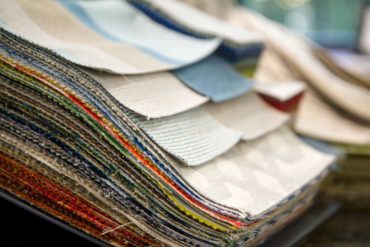 Mary Terry believes that everyone’s “hunkering down” due to the uncertainty in politics.
Mary Terry believes that everyone’s “hunkering down” due to the uncertainty in politics.
“Home you can be certain of and be in control of,” she explains.
Other trends she’s observing:
- Burgundy is back in colors, and brown is coming as well.
- Solid surfaces are popular.
- Fabrics are rich, textual and “impervious to life.”
- Rugs over hardwood are trendy, as well as luxury vinyl tile.
- Furniture is comfortable, cozy and easy to live on.
- Lots of lighting wattage is a must for the Northwest.
- Popular finishes include oil-rubbed bronze; brass also has appeal again.
- Barn doors, mullioned windows and wood are trending in doors and windows.
- Rice wall paper is available in every color and size.
- Soft window coverings — using full drapes on all the windows.
Her advice to the homeowner is, “Be realistic about your project, time and money. Only HGTV can do it in a week.”
 Catherine Shively
Catherine Shively
Designs By Envision
Gig Harbor • 253-225-3180
qrfvtafolpf@ubgznvy.pbz
As an interior designer, Catherine Shively is passionate about the interior spaces of residential, commercial and even exteriors. Her love of design started as a very young girl and continues today. Being creative and working with clients to see their desire happen is exciting and satisfying. Her background and education is ongoing so she can provide the latest trends and products to her clients.
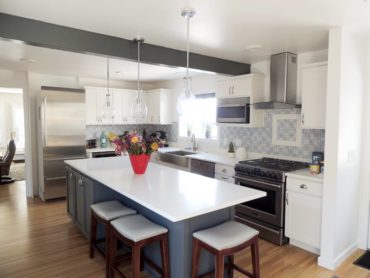 The overall trends that Catherine Shively is seeing include simple lines in the kitchen, with functional cabinets for easy cooking along with organic material accents for a comfortable vibe; comfortable seating for conversation areas with family and friends in living spaces; and glamour mixed with industrial and splashes of color.
The overall trends that Catherine Shively is seeing include simple lines in the kitchen, with functional cabinets for easy cooking along with organic material accents for a comfortable vibe; comfortable seating for conversation areas with family and friends in living spaces; and glamour mixed with industrial and splashes of color.
Colors: Deep rich greens, French blues and neutrals.
Counter surfaces: Less busy granite surfaces and more manmade products that are more neutral.
Fabrics: Plaids with traditional colors and solids with a mix of colors.
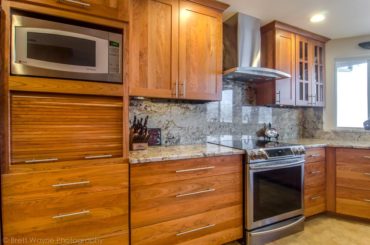 Flooring: Wood continues to be popular due the variety of stains that can be applied to it. Large tiles are still well liked due the feeling it gives a space.
Flooring: Wood continues to be popular due the variety of stains that can be applied to it. Large tiles are still well liked due the feeling it gives a space.
Furniture: Lean, upholstered, comfortable chairs along with smaller sectionals for better space planning and options.
Lighting: Modern, unique chandeliers that make a statement with a mix of glamour and industrial, clear glass fixtures with interesting bulbs for interest, and integrated lighting and accent lighting.
Finishes: Dark walls mixed with light walls, along with area rugs to warm up the space.
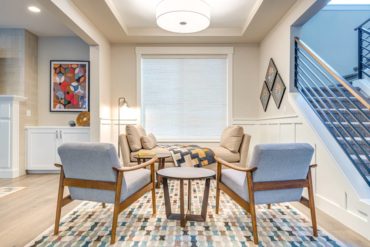 Windows and doors: Windows with simple trim lines, not decorative, to provide more viewing and natural light. Doors with two or five panels. This provides a contemporary but craftsman look but fits into most interiors.
Windows and doors: Windows with simple trim lines, not decorative, to provide more viewing and natural light. Doors with two or five panels. This provides a contemporary but craftsman look but fits into most interiors.
Window treatments: Cornices with pull-down window shades, along with remote controls for opening and closing them.
New green options: Cork, leather tiles, bamboo and bio-glass.
Natural materials: Countertops, tables made of wood with metal bases and trim.
Her advice to the homeowner is, “Research through NKBA kitchen or bath designers in your area. Research through Houzz for a local interior designer who shows similar design style and philosophy you have.”
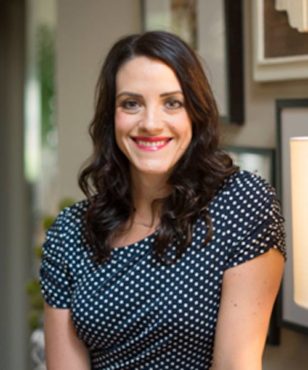
Stefanie Brooks
SB Interior Design
Tacoma • 253-225-6545
sbinteriordesign.com
vasb@fovagrevbeqrfvta.pbz
With a keen eye for design, thoughtful attention to detail and fabulous style, Stefanie Brooks brings creativity and enthusiasm that enhances your design experience. In her 14-year career, she has served as lead designer or team player on a wide variety of projects from custom homes and remodels for kitchens, baths, whole houses, and commercial projects, to providing many homes in Western Washington with carefully selected furnishings and adornments. Brooks strongly believes that the most essential hallmarks of a designer are impeccable communication skills and the ability to be a great listener. She truly heeds her clients’ preferences and concerns throughout the entire design process. Brooks commitment to community is reflected in her many business relationships and active involvement with the Master Builders Association, Remodelers Council and Design Professionals Council.
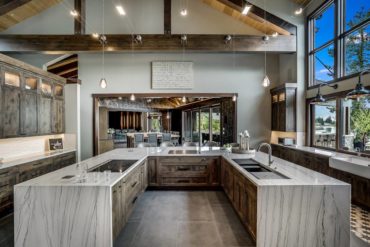 Although clients still love shades of gray and white, Stefanie Brooks says there’s a shift in furniture, cabinetry and materials, heading more in the middle of warm and cool tones. Other overall trends include light oak with transparent gray or ebonized stains, creating a current look while still maintaining the warm undertones of natural wood. Lighter woods such as white oak, beech and birch are favored over dark dreary species such as cherry, and darker stained woods.
Although clients still love shades of gray and white, Stefanie Brooks says there’s a shift in furniture, cabinetry and materials, heading more in the middle of warm and cool tones. Other overall trends include light oak with transparent gray or ebonized stains, creating a current look while still maintaining the warm undertones of natural wood. Lighter woods such as white oak, beech and birch are favored over dark dreary species such as cherry, and darker stained woods.
“Wallpaper is also hot and has been for many years, although I think it’s becoming even more so once clients can see the current textures and patterns that are offered,” she says. “I like to call this the replacement of the painted accent wall (can’t recall the last time I did a painted accent wall). I like to tell clients, ‘It’s not your grandma’s wallpaper,’ and they seem to get good flashbacks.”
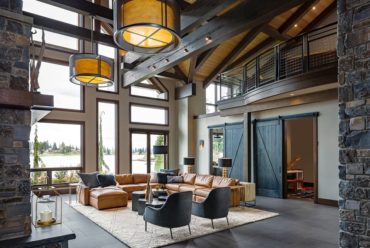 Colors: For paint colors, lighter and brighter, greige, bright white or whites with a touch of warmth for the main wall color. These tones allow a nice subtle backdrop to display art collections without distraction.
Colors: For paint colors, lighter and brighter, greige, bright white or whites with a touch of warmth for the main wall color. These tones allow a nice subtle backdrop to display art collections without distraction.
Counter surfaces: Quartz still remains number one for most because of the durability, low maintenance and color consistency of manmade stone over granite.
“However, I still use natural stone countertops such as marble, quartzite and granite,” Brooks says. “It really just varies from project to project and the look we are achieving. As far as finishes, satin, honed, suede and etched are all very popular over the standard polished finish.”
Fabrics: Textiles are amazing, and there are constantly new patterns and textures. Bold colors and bold patterns are great for the one statement piece (side chair, ottoman); however, using textural neutrals on the larger pieces like a sofa allows for a less expensive way to swap out rugs, pillows, throws etc.
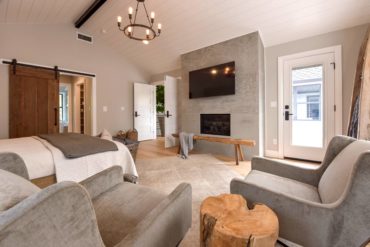 Floor coverings: Prefinished hardwoods dominate, and lately, larger- format porcelain tiles (24 by 48). Luxury vinyl plank is still very desirable to those who have pets and kids and are looking for a waterproof, durable solution.
Floor coverings: Prefinished hardwoods dominate, and lately, larger- format porcelain tiles (24 by 48). Luxury vinyl plank is still very desirable to those who have pets and kids and are looking for a waterproof, durable solution.
“It used to be more commonly used in the basements of homes and now I have several clients wanting it on the main floors of their homes,” she says. “Although it is not the real deal, the various manufacturers have come out with some very nice species, colors and styles. Could it be a fad? Perhaps, but I don’t see it leaving any time soon.”
Furniture: Brooks foresees cleaner lines vs. traditional lines, lighter bleached wood finishes, blackened oaks, velvet, caning, vintage pieces reproduced and textural natural textiles.
Lighting: This is the jewelry to every home, and it’s where Brooks usually sees clients step outside of their comfort zones a little bit.
“Lighting has come a very long way and it’s so fun to mix up the styles, finishes and shapes,” she says. “Lighting styles are all over the place, which makes options nearly endless.”
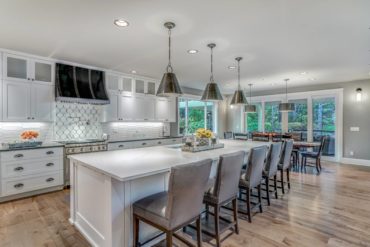 Custom lighting has become even more popular and homeowners are willing to spend more for that one statement piece and then stay more moderately priced in the other areas. Some of the things trending include clear glass single pendants, large chandeliers with glass pieces hanging at varied heights, metal drum fixtures, rattan and frosted glass globes in a midcentury style.
Custom lighting has become even more popular and homeowners are willing to spend more for that one statement piece and then stay more moderately priced in the other areas. Some of the things trending include clear glass single pendants, large chandeliers with glass pieces hanging at varied heights, metal drum fixtures, rattan and frosted glass globes in a midcentury style.
Finishes: Black is hot and has taken over the oil-rubbed bronze, while brushed nickel will remain a staple. Brooks sees chrome and polished nickel sticking around and says brass still remains on the scene; however, she finds that clients prefer to use that in small doses, with the fear it will be gone tomorrow.
Windows and doors: This generally depends on the style of the home and the budget of the project. In custom homes, black windows are a favorite and classic white is versatile with most styles. For doors, simple shaker doors are versatile, with various styles, and never seem to date themselves.
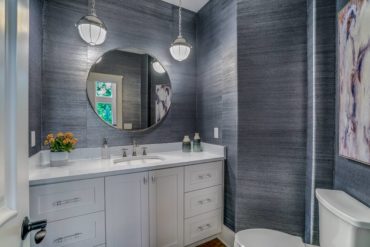 Window treatments: Waterfront and view homes call for solar shades. No one wants to obstruct their views; however, they still get heat and sun exposure. Simple drapery panels in solid colors in linen or velvet are always a favorite for bedrooms. Wide-slat, white shutters are also appealing to clients.
Window treatments: Waterfront and view homes call for solar shades. No one wants to obstruct their views; however, they still get heat and sun exposure. Simple drapery panels in solid colors in linen or velvet are always a favorite for bedrooms. Wide-slat, white shutters are also appealing to clients.
Her advice to homeowners is to have the right team on their project: “a contractor who thinks outside of the box and is willing to do different things, a designer who listens to you and your needs and desired outcome for the project, and quality subcontractors who can execute the design plan beautifully.”
“Once you have this dream team, you should get the advice and answers you need, along with a quality finished project,” she says.
 Michele Doyle
Michele Doyle
MD Design Group
Poulsbo • 360-689-4156
mddesigngrp.com
Michele Doyle founded Michele Interiors, Inc. in 2005 after completing her interior design training at the Seattle Art Institute. She has been successfully serving Kitsap, Jefferson, Pierce and King counties ever since. Fast forward 10 years and her business is now MD Design Group — a team of talented and service-minded collaborators ready to guide clients through the interior design process and getting to the heart of the clients’ needs to create spaces that feel natural to them.
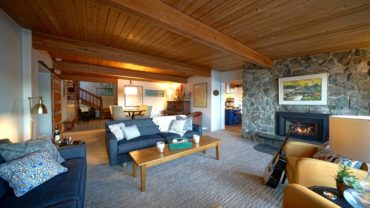 Michele Doyle says it’s not hard to spot trends by watching home-improvements shows, looking through a magazine or visiting showrooms. What can be difficult is making decisions about finishes, fixtures and furnishings in your own home and trying to decide what’s right for you.
Michele Doyle says it’s not hard to spot trends by watching home-improvements shows, looking through a magazine or visiting showrooms. What can be difficult is making decisions about finishes, fixtures and furnishings in your own home and trying to decide what’s right for you.
“There are endless choices on the market, so which choices are the right ones? Do you follow a trend or do you blaze your own trail? You may be able to answer that yourself, or you may need the help of a designer,” she says.
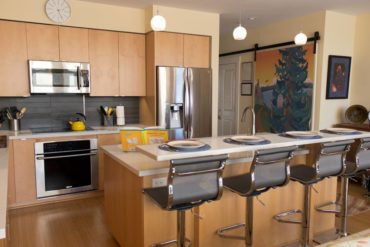 The biggest trend she’s noticing is black in a variety of applications.
The biggest trend she’s noticing is black in a variety of applications.
“Black windows (and doors) are amazing because they work with many of the common architectural styles we see here in the Pacific Northwest. Some would argue they work everywhere,” she says.
The great thing about black windows and doors is that they recede so that beautiful views stand out.
“And you don’t need to fear pairing them with white walls, as the contrast between white and black is as timeless as it comes,” she says.
Black in plumbing fixtures is very versatile because it shows beautifully against color and is eye-cathing against a more classic background such as white marble.
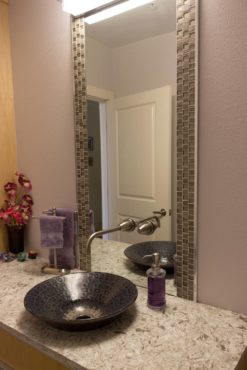 “Don’t be shy with black,” Doyle says, noting that Rohl has come out with a black stainless steel sink that’s gorgeous, and the color goes all the way through because it’s not applied. The stainless “turns” black when it’s heated.
“Don’t be shy with black,” Doyle says, noting that Rohl has come out with a black stainless steel sink that’s gorgeous, and the color goes all the way through because it’s not applied. The stainless “turns” black when it’s heated.
“We’ve also seen stainless in e-granite (which is a composite) and enameled cast iron,” she says. “Hard water should be treated to help keep your black plumbing looking good. But hard water wreaks havoc on all plumbing, not just black.”
Other elements in your home that can look amazing in black are cabinet pulls and knobs, light fixtures and even wall color (as an accent).
Cabinetry: White-painted and wood cabinets will always be popular options for kitchens and bathrooms.
“But have you noticed laminate cabinets lately? I’m not talking about cabinets from IKEA (not slamming them either). Imported (European) cabinet companies have been making very high-end cabinetry from high-pressure laminate for years but it’s coming into the mainstream in a big way,” Doyle says.
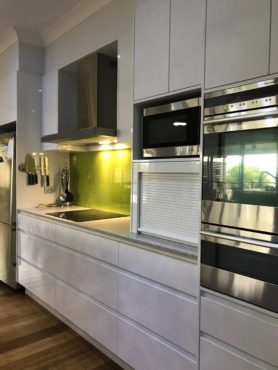 Many custom cabinetmakers are creating high-gloss finishes as well as beautiful woodgrain finishes, but now they’re also using laminate.
Many custom cabinetmakers are creating high-gloss finishes as well as beautiful woodgrain finishes, but now they’re also using laminate.
“Having access to suppliers that produce gorgeous doors and panels in laminates that are not only convincing in mimicking wood, but textiles as well, has made these custom shops competitive against the very high-end European imports,” she says. “Laminate cabinets are extremely easy to maintain, durable and beautiful. They can work in both modern and rustic design styles.”
Counter surfaces: Manmade quartz is still the most popular choice. But there’s been a large shake-up in the industry because of the tariffs imposed against imported good.
“So we’ve been seeing suppliers seeking out alternative sources for this highly desirable product,” she says. “In addition, we’re seeing fabricators purchase in bulk and offering per square foot pricing for specific colors from certain companies, including the still hot patterns that look like Calacutta and Carrara marble.”
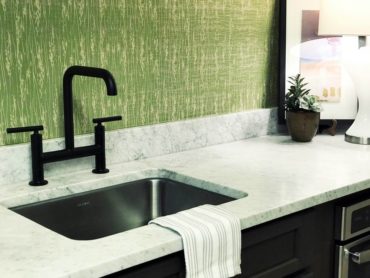 Her clients have also shown great interest in concrete countertops and even some of the more exotic granites and natural quartzite stones. The patterns and colors must be unique and interesting. Since these stones tend to be more expensive, you’ll see them combined with less expensive materials. Sometimes they’re combined with another granite (or soapstone) or even a quartz.
Her clients have also shown great interest in concrete countertops and even some of the more exotic granites and natural quartzite stones. The patterns and colors must be unique and interesting. Since these stones tend to be more expensive, you’ll see them combined with less expensive materials. Sometimes they’re combined with another granite (or soapstone) or even a quartz.
Flooring: More people are still opting for wood or luxury vinyl plank. Wide planks are still in, as are the varied width planks but Doyle sees people starting to move away from the overly rustic look and seeking out softer, less contrasting patterns.
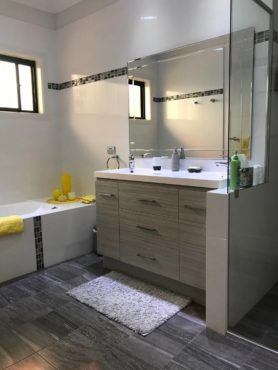 “The manufacturers haven’t caught on in a big way yet but there are a few out there that have,” she says.
“The manufacturers haven’t caught on in a big way yet but there are a few out there that have,” she says.
As for carpet, one of the biggest complaints has been the ability to keep it clean — homeowners want stain resistance, and Shaw has been able to deliver a terrific carpet that actually is.
“And it looks and feels great,” she says. “Since Shaw has come out with this line, there have been a few others to follow suit so we are seeing the pricing come down on this product.”
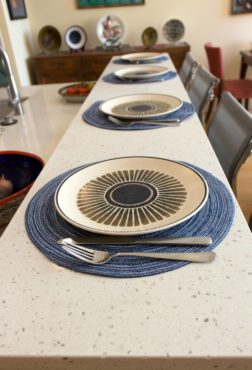 The carpet is essentially waterproof — spills sit on top of the carpet and do not absorb in. But just in case, there’s also a waterproof backing as a failsafe.
The carpet is essentially waterproof — spills sit on top of the carpet and do not absorb in. But just in case, there’s also a waterproof backing as a failsafe.
“I installed this beautiful carpet in a client’s home and someone actually tracked grease on the floor, and it cleaned up like a breeze,” Doyle says.
Her advice for those struggling with selecting the right products or creating a cohesive look for the home is to speak with a qualified and knowledgeable professional.
“Just because something is trending doesn’t make it right for you. After all, you have to live with it and love it (and pay for it),” she says. “Most designers should be able to work with you in whatever capacity suits you best, either as a full engagement (collaborating with you from beginning to end) or as a consultative engagement (as needed, or just to reassure you that you’re on the right track).”
She says a great designer should listen to you and involve you in the creative process.
“Expect to be educated, guided — maybe a bit pushed — and delighted,” she says. “And most importantly, expect to have fun.”




